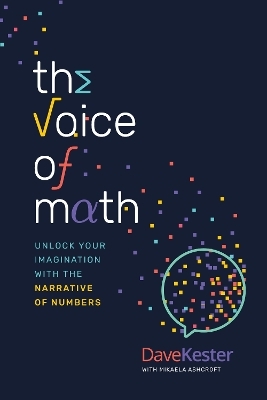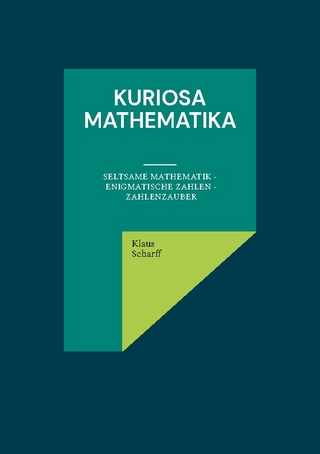
Fibonacci and Lucas Numbers with Applications, Volume 1
John Wiley & Sons Inc (Verlag)
978-1-118-74212-9 (ISBN)
Praise for the First Edition “ …beautiful and well worth the reading … with many exercises and a good bibliography, this book will fascinate both students and teachers.” Mathematics Teacher
Fibonacci and Lucas Numbers with Applications, Volume I, Second Edition provides a user-friendly and historical approach to the many fascinating properties of Fibonacci and Lucas numbers, which have intrigued amateurs and professionals for centuries. Offering an in-depth study of the topic, this book includes exciting applications that provide many opportunities to explore and experiment.
In addition, the book includes a historical survey of the development of Fibonacci and Lucas numbers, with biographical sketches of important figures in the field. Each chapter features a wealth of examples, as well as numeric and theoretical exercises that avoid using extensive and time-consuming proofs of theorems. The Second Edition offers new opportunities to illustrate and expand on various problem-solving skills and techniques. In addition, the book features:
• A clear, comprehensive introduction to one of the most fascinating topics in mathematics, including links to graph theory, matrices, geometry, the stock market, and the Golden Ratio
• Abundant examples, exercises, and properties throughout, with a wide range of difficulty and sophistication
• Numeric puzzles based on Fibonacci numbers, as well as popular geometric paradoxes, and a glossary of symbols and fundamental properties from the theory of numbers
• A wide range of applications in many disciplines, including architecture, biology, chemistry, electrical engineering, physics, physiology, and neurophysiology
The Second Edition is appropriate for upper-undergraduate and graduate-level courses on the history of mathematics, combinatorics, and number theory. The book is also a valuable resource for undergraduate research courses, independent study projects, and senior/graduate theses, as well as a useful resource for computer scientists, physicists, biologists, and electrical engineers.
Thomas Koshy, PhD, is Professor Emeritus of Mathematics at Framingham State University in Massachusetts and author of several books and numerous articles on mathematics. His work has been recognized by the Association of American Publishers, and he has received many awards, including the Distinguished Faculty of the Year. Dr. Koshy received his PhD in Algebraic Coding Theory from Boston University.
“Anyone who loves mathematical puzzles, number theory, and Fibonacci numbers will treasure this book. Dr. Koshy has compiled Fibonacci lore from diverse sources into one understandable and intriguing volume, [interweaving] a historical flavor into an array of applications.” Marjorie Bicknell-Johnson
Thomas Koshy, PhD, is Professor Emeritus of Mathematics at Framingham State University in Massachusetts and author of several books and numerous articles on mathematics. His work has been recognized by the Association of American Publishers, and he has received many awards, including the Distinguished Faculty of the Year. Dr. Koshy received his PhD in Algebraic Coding Theory from Boston University.
1 Leonardo Fibonacci 9
2 Fibonacci Numbers 13
2.1 Fibonacci's Rabbits 13
2.2 Fibonacci Numbers 14
2.3 Fibonacci and Lucas Curiosities 17
3 Fibonacci Numbers in Nature 27
3.1 Fibonacci, Flowers, and Trees 28
3.2 Fibonacci and Male Bees 31
3.3 Fibonacci, Lucas, and Subsets 32
3.4 Fibonacci and Sewage Treatment 34
3.5 Fibonacci and Atoms 35
3.6 Fibonacci and Reflections 36
3.7 Paraffins and Cycloparaffins 38
3.8 Fibonacci and Music 41
3.9 Fibonacci and Poetry 42
3.10 Fibonacci and Neurophysiology 43
3.11 Electrical Networks 45
4 Additional Fibonacci and Lucas Occurrences 53
4.1 Fibonacci Occurrences 53
4.2 Fibonacci and Compositions 58
4.3 Fibonacci and Permutations 61
4.4 Fibonacci and Generating Sets 63
4.5 Fibonacci and Graph Theory 64
4.6 Fibonacci Walks 66
4.7 Fibonacci Trees 68
4.8 Partitions 71
4.9 Fibonacci and the Stock Market 72
5 Fibonacci and Lucas Identities 77
5.1 Spanning Tree of a Connected Graph 79
5.2 Binet's Formulas 83
5.3 Cyclic Permutations and Lucas Numbers 91
5.4 Compositions Revisited 94
5.5 Number of Digits in Fn and Ln 94
5.6 Theorem 5.8 Revisited 95
5.7 Catalan's Identity 99
5.8 Additional Fibonacci and Lucas Identities 102
5.9 Fermat and Fibonacci 108
5.10 Fibonacci and 110
6 Geometric Illustrations and Paradoxes 117
6.1 Geometric Illustrations 117
6.2 Candido's Identity 121
6.3 Fibonacci Tessellations 123
6.4 Lucas Tessellations 123
6.5 Geometric Paradoxes 124
6.6 Cassini-Based Paradoxes 124
6.7 Additional Paradoxes 129
7 Gibonacci Numbers 133
7.1 Gibonacci Numbers 133
7.2 Germain's Identity 139
8 Additional Fibonacci and Lucas Formulas 145
8.1 New Explicit Formulas 145
8.2 Additional Formulas 148
9 The Euclidean Algorithm 159
9.1 The Euclidean Algorithm 160
9.2 Formula (5.5) Revisited 162
9.3 Lamé's Theorem 164
10 Divisibility Properties 167
10.1 Fibonacci Divisibility 167
10.2 Lucas Divisibility 173
10.3 Fibonacci and Lucas Ratios 173
10.4 An Altered Fibonacci Sequence 178
11 Pascal's Triangle 185
11.1 Binomial Coefficients 185
11.2 Pascal's Triangle 186
11.3 Fibonacci Numbers and Pascal’s Triangle 188
11.4 Another Explicit Formula for Ln 191
11.5 Catalan's Formula 192
11.6 Additional Identities 192
11.7 Fibonacci Paths of a Rook on a Chessboard 194
12 Pascal-like Triangles 199
12.1 Sums of Like-Powers 199
12.2 An Alternate Formula for Ln 202
12.3 Differences of Like-Powers 202
12.4 Catalan's Formula Revisited 204
12.5 A Lucas Triangle 205
12.6 Powers of Lucas Numbers 209
12.7 Variants of Pascal's Triangle 211
13 Recurrences and Generating Functions 219
13.1 LHRWCCs 219
13.2 Generating Functions 223
13.3 A Generating Function For F3n 233
13.4 A Generating Function For F3 n 234
13.5 Summation Formula (5.1) Revisited 234
13.6 A List of Generating Functions 235
13.7 Compositions Revisited 238
13.8 Exponential Generating Functions 239
13.9 Hybrid Identities 241
13.10Identities Using the Differential Operator 242
14 Combinatorial Models I 249
14.1 A Fibonacci Tiling Model 249
14.2 A Circular Tiling Model 255
14.3 Path Graphs Revisited 259
14.4 Cycle Graphs Revisited 262
14.5 Tadpole Graphs 263
15 Hosoya's Triangle 271
15.1 Recursive Definition 271
15.2 A Magic Rhombus 273
16 The Golden Ratio 279
16.1 Ratios of Consecutive Fibonacci Numbers 279
16.2 The Golden Ratio 281
16.3 Golden Ratio as Nested Radicals 285
16.4 Newton's Approximation Method 286
16.5 The Ubiquitous Golden Ratio 288
16.6 Human Body and the Golden Ratio 289
16.7 Violin and the Golden Ratio 290
16.8 Ancient Floor Mosaics and the Golden Ratio 290
16.9 Golden Ratio in an Electrical Network 290
16.10Golden Ratio in Electrostatics 291
16.11Golden Ratio by Origami 292
16.12Differential Equations 297
16.13Golden Ratio in Algebra 299
16.14Golden Ratio in Geometry 300
17 Golden Triangles and Rectangles 309
17.1 Golden Triangle 309
17.2 Golden Rectangles 314
17.3 The Parthenon 317
17.4 Human Body and the Golden Rectangle 318
17.5 Golden Rectangle and the Clock 319
17.6 Straightedge and Compass Construction 320
17.7 Reciprocal of a Rectangle 321
17.8 Logarithmic Spiral 322
17.9 Golden Rectangle Revisited 324
17.10Supergolden Rectangle 324
18 Figeometry 329
18.1 The Golden Ratio and Plane Geometry 329
18.2 The Cross of Lorraine 335
18.3 Fibonacci Meets Appollonius 337
18.4 A Fibonacci Spiral 338
18.5 Regular Pentagons 339
18.6 Trigonometric Formulas for Fn 343
18.7 Regular Decagon 347
18.8 Fifth Roots of Unity 348
18.9 A Pentagonal Arch 351
18.10 Regular Icosahedron and Dodecahedron 351
18.11 Golden Ellipse 352
18.12 Golden Hyperbola 354
19 Continued Fractions 361
19.1 Finite Continued Fractions 361
19.2 Convergents of a Continued Fraction 364
19.3 Infinite Continued Fractions 366
19.4 A Nonlinear Diophantine Equation 368
20 Fibonacci Matrices 371
20.1 The Q-Matrix 371
20.2 Eigenvalues of Qn 378
20.3 Fibonacci and Lucas Vectors 384
20.4 An Intriguing Fibonacci Matrix 386
20.5 An Infinite-Dimensional Lucas Matrix 391
20.6 An Infinite-Dimensional Gibonacci Matrix 397
20.7 The Lambda Function 398
21 Graph-theoretic Models I 407
21.1 A Graph-theoretic Model for Fibonacci Numbers 407
21.2 Byproducts of the Combinatorial Models 409
21.3 Summation Formulas 415
22 Fibonacci Determinants 419
22.1 An Application to Graph Theory 419
22.2 The Singularity of Fibonacci Matrices 425
22.3 Fibonacci and Analytic Geometry 427
23 Fibonacci and Lucas Congruences 437
23.1 Fibonacci Numbers Ending in Zero 437
23.2 Lucas Numbers Ending in Zero 437
23.3 Additional Congruences 438
23.4 Lucas Squares 439
23.5 Fibonacci Squares 440
23.6 A Generalized Fibonacci Congruence 442
23.7 Fibonacci and Lucas Periodicities 449
23.8 Lucas Squares Revisited 450
23.9 Periodicities Modulo 10n 452
24 Fibonacci and Lucas Series 461
24.1 A Fibonacci Series 461
24.2 A Lucas Series 463
24.3 Fibonacci and Lucas Series Revisited 464
24.4 A Fibonacci Power Series 467
24.5 Gibonacci Series 472
24.6 Additional Fibonacci Series 474
25 Weighted Fibonacci and Lucas Sums 481
25.1 Weighted Sums 481
25.2 Gauthier's Differential Method 488
26 Fibonometry I 495
26.1 Golden Ratio and Inverse Trigonometric Functions 495
26.2 Golden Triangle Revisited 496
26.3 Golden Weaves 497
26.4 Additional Fibonometric Bridges 498
26.5 Fibonacci and Lucas Factorizations 504
27 Completeness Theorems 509
27.1 Completeness Theorem 509
27.2 Egyptian Algorithm for Multiplication 510
28 The Knapsack Problem 513
28.1 The Knapsack Problem 513
29 Fibonacci and Lucas Subscripts 517
29.1 Fibonacci and Lucas Subscripts 517
29.2 Gibonacci Subscripts 519
29.3 A Recursive Definition of Yn 520
30 Fibonacci and the Complex Plane 525
30.1 Gaussian Numbers 525
30.2 Gaussian Fibonacci and Lucas Numbers 526
30.3 Analytic Extensions 530
1 A.1 Fundamentals 537
SOLUTIONS TO ODD-NUMBERED EXERCISES 575
| Erscheint lt. Verlag | 30.1.2018 |
|---|---|
| Reihe/Serie | Wiley Series in Pure and Applied Mathematics ; 1 |
| Verlagsort | New York |
| Sprache | englisch |
| Maße | 147 x 239 mm |
| Gewicht | 1089 g |
| Themenwelt | Mathematik / Informatik ► Mathematik ► Arithmetik / Zahlentheorie |
| Mathematik / Informatik ► Mathematik ► Geschichte der Mathematik | |
| ISBN-10 | 1-118-74212-5 / 1118742125 |
| ISBN-13 | 978-1-118-74212-9 / 9781118742129 |
| Zustand | Neuware |
| Haben Sie eine Frage zum Produkt? |
aus dem Bereich


